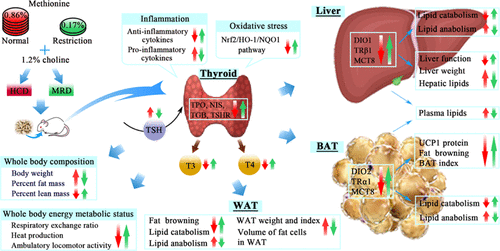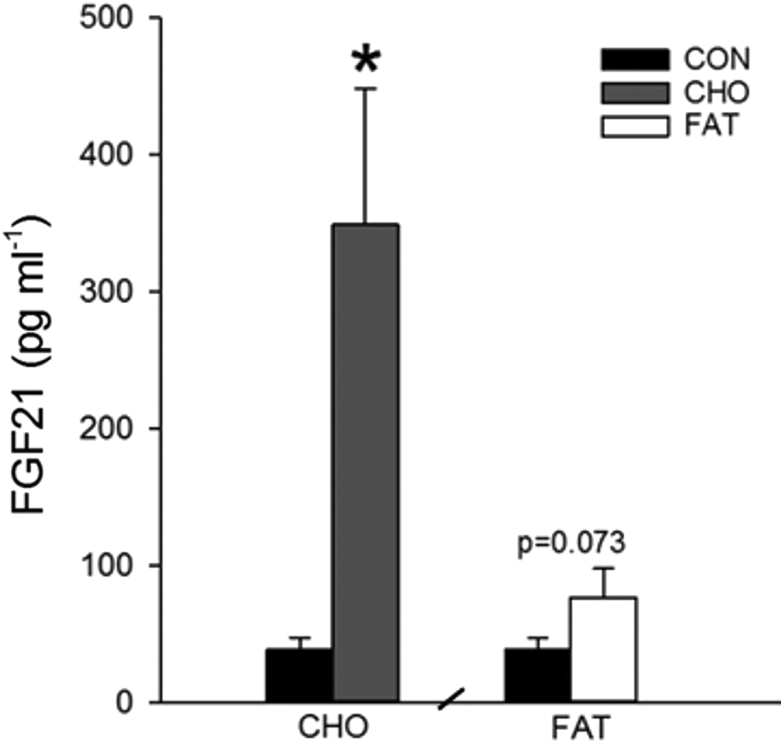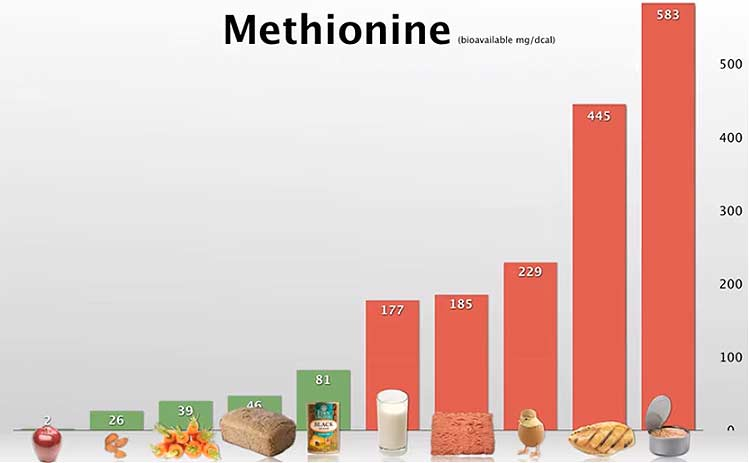Methionine/Cysteine restriction increases longetivity AND energy expenditure
-
Ray Peat mentioned methionine restriction in his last newsletter. I found this study quite a nice read on this topic:
https://www.ncbi.nlm.nih.gov/pmc/articles/PMC9936953/"The original description of dietary methionine restriction (MR) used semipurified diets to limit methionine intake to 20% of normal levels, and this reduction in dietary methionine increased longevity by ~30% in rats. The MR diet also produces paradoxical increases in energy intake and expenditure and limits fat deposition while reducing tissue and circulating lipids and enhancing overall insulin sensitivity. In the years following the original 1993 report, a comprehensive effort has been made to understand the nutrient sensing and signaling systems linking reduced dietary methionine to the behavioral, physiological, biochemical, and transcriptional components of the response. Recent work has shown that transcriptional activation of hepatic fibroblast growth factor 21 (FGF21) is a key event linking the MR diet to many but not all components of its metabolic phenotype. These findings raise the interesting possibility of developing therapeutic, MR-based diets that produce the beneficial effects of FGF21 by nutritionally modulating its transcription and release."
Gelatin for the win! Strange that it is not mentioned in the study.
-
@Kasper do you know of anyone successfully implementing methionine restriction? It seems Ray was lowering protein overall, perhaps for this purpose, the last year of his life. One study in rats reduced total methionine intake to 0.12% of calories and saw a 40% increase of lifespan, if I remember correctly. It also prevented insulin resistance and obesity even on a high fat diet. Additionally, the researchers found that the MR could be done intermittently, 3 days a week, with similar results.
The only way I've been able to construct a reasonably nutritious diet that brings down methionine to these levels is through a more fruitarian base, e.g. a gallon of OJ plus ad libitum fruit daily plus a can of oysters and a serving of beef liver once a week covers most nutrients. Maybe add some calcium, vit d, K2, e. Just the OJ alone provides about 30 grams of protein. And if the diet only needs to be on point 3 out of 7 days, the protein could be bumped up every few days.
Does anyone have any experience trying something like this or have a more sensible model to experiment with?
P.S. the diet doesn't have to be this low in fat, I don't think. The above diet with some added cream or coconut oil might work as well if successful MR really comes down to percentage of calories.
-
@Kasper said in Methionine/Cysteine restriction increases longetivity AND energy expenditure:
FGF21
FGF21
The benefits of MR are almost exclusviely downstream from FGF21. ("...mice lacking FGF21 fail to exhibit metabolic responses to protein restriction...")
https://pubmed.ncbi.nlm.nih.gov/35393401/
Interestingly FGF21 fails to have effects when the longevity gene klotho is silenced, so FGF21's effects seem to depend on klotho.
https://pubmed.ncbi.nlm.nih.gov/23209629/-
Ketogenic diets decrease FGF21 (and klotho) as per this study, so they are not good for replicating MR
https://www.ncbi.nlm.nih.gov/pmc/articles/PMC4431718/ -
Low protein diet increases FGF21 more, but high protein diet decreases liver fat more
https://raypeatforum.com/community/threads/high-protein-diet-reduces-hepatic-fat-than-low-protein-diet.35461/ -
Low carb, high protein diet decreased FGF21 by 54%
https://pubmed.ncbi.nlm.nih.gov/38379856/ -
Molecular hydrogen increases FGF21
https://pubmed.ncbi.nlm.nih.gov/21293445/ -
high sucrose diet increases FGF21
https://pubmed.ncbi.nlm.nih.gov/28886439/ -
Concentric exercise, in this case, treadmill uphill walk variations, increase FGF21 by 66% in 2 weeks in humans
https://pubmed.ncbi.nlm.nih.gov/22701542/
-
-
Wow.
"...MRD (0.17% methionine + 1.20% choline) for 90 consecutive days. We found that MRD reduced body weight and fat mass; increased heat production and ambulatory locomotor activity; reduced hepatic and plasma lipid levels, hepatic fatty infiltration area, and adipocyte volume in white and brown adipose tissue; promoted fat browning, especially upregulated gene and protein expression levels of uncoupling protein 1 (UCP1); and promoted fat catabolism and inhibited fat anabolism in the liver and adipose tissue. Moreover, MRD increased antioxidant defenses and reduced inflammatory cytokine levels in the thyroid, blood, and liver. Furthermore, # MRD improved thyroid morphological structure, promoted the synthesis and secretion of thyroid hormones, and enhanced the actions of thyroid hormones on its receptor organs (liver and adipose tissue). These findings suggested that MRD promoted fat browning and attenuated hepatic lipid accumulation in HCD mice associated with the improvement of thyroid function."

-
@Benjo this is what I’m always curious about. It seems like it would be tough to construct a diet low in methionine, while hitting key macros/micros, but maybe it’s as simple as the rice diet three days a week? Despite the name, patients on the rice diet ate fruit, juice, and sugar in addition to the rice, (and I have a personal theory that you could add butter to the rice and still have it work-just to make it a little more palatable).
-
Protein restriction might be the best option to increase FGF21 and thus longevity, but not the easiest. Something that everybody can do at home and that Peat had recommended for decades is to eat lots of carbs.
This human study shows that Increasing carb intake is way more effective at increasing FGF21 than incresaing fat intake.
The protein intake was the same during the whole study.The FGF21 concentration increased 8-fold in the high carb group!
"After CHO, plasma FGF21 concentration increased 8-fold compared to CON (329 ± 99 vs. 39 ± 9 pg ml-1, p < 0.05)."
So protein restriction might not even be necessary.

Another interesting fun fact is that the high carb diet increased the concentration of palmitoleic acid by almost 150%. Its interesting that when the body makes new fat that it is a pro-metabolic MUFA. Palmitoelic acid is contained in macadamia nuts a lot.
-
I always suspected there was more to semaglutide than it lowering appetite.
It increases FGF21 sensitivity. So in a way it is mimicking methionine restriction.
In many diseases FGF21 is high (I assume as an adaptive response), but similarly as in diabetes and insulin, their body is resistant to it. So there is such a thing as FGF21 resistance, which is ameliorated by semaglutide, leading to weight loss.
-
This is a plant based diet. It is low in methionine. Not zero, but low compared to adding animal products.
-
@Mauritio great find, thank you!!
-
T3 increases FGF21 as well.
https://pubmed.ncbi.nlm.nih.gov/20236931/ -
@evan-hinkle you might be right regarding the rice diet. Rice does have protein, of course. But if the diet included plenty of fruit and sugar, and maybe coconut oil or butter, the percent of methionine could be low enough. Cronometer is reasonably helpful crunching those ratios.
Brad Marshall of fireinabottle and the old croissant diet of a couple years ago has been doing something similar, except he's focusing on the branch chain amino acids (valine, leucine, and isoleucine) instead of methionine. He's also more into starch, so he's doing casava pancakes and sweet potato rice noodles (which have zero protein and virtually no nutrients.)
OJ is an easy base for the diet because of the nutrient values (considerable in a whole gallon) but that much liquid could be a turn-off.
I've been dabbling with this idea for a couple days. It's hard for me to drink morning coffee without milk. I may go back to using cream or even coconut cream and see how it feels.
I'd love to hear anyone's experience/success trying this.
-
@Benjo - I have been leaning into a lower methionine diet for several months. I keep methionine below 1 gram/day and my cysteine is in the same ballpark. It is very doable for me. I do not obsess about getting my methionine closer to zero.
I typically get most of my calories from white rice, lentils and sweet potatoes. If you look to epidemiological studies, billions of Chinese have lived on a rice based diet for generations. The traditional Okinawan diet was based on sweet potatoes.
I am a full-grown male and I am not concerned about stunting my growth. I have an inexpensive bioimpedance scale that I purchased years ago. It montiors about 10 different things and I pay attention my muscle weight and bone weight to make sure I am doing no harm to myself.
-
I used to do juice fasting when I first tried to fix my thyroid. At the time I drank juices that had a ton of veggies in them, but you could easily swap that out for predominantly fruity juices.
If one really only needs to restrict methionine for 3 days a week, perhaps three single day juice days, (non-consecutive) a week would be another method. I always found juices very satiating, (you would think they wouldn’t be, but they are pretty dense).
I’m just trying to come up with as many example diets as possible, and hoping that you all can poke holes in them for me.
-
I'm skeptical of NAC supplementation for this reason, as well as for the fact that NAC supplementation does not raise glutathione levels except in acute cases of stark depletion
-
My diet includes about 10 grams of glycine each day. I add glycine in part to try to reduce the negative effects of glyphosate that is sprayed on our commerically produced foods. Glycine also helps with reducing the impact of methionine.
-
@Mauritio said in Methionine/Cysteine restriction increases longetivity AND energy expenditure:
Concentric exercise, in this case, treadmill uphill walk variations, increase FGF21 by 66% in 2 weeks in humans
https://pubmed.ncbi.nlm.nih.gov/22701542/Interestingly upstairs walking, a form a concentric exercise, has by far the highest calorie expenditure amongst all the sports tested.
https://x.com/T3MaxxiAlt/status/1759793246769987880
BTW if anyone finds any other ways to boost FGF22 let me know. I feel like boosting FGF22 is a better way key to get the benefits of MR without having to eat in a too restricted way.
I think methionine restriction boosts FGF22 something like 800% and I have yet to find anything else that comes even close to that . -
My diet includes a large amount of glycine. Yesterday I entered my food into cronometer.com and my methionine:glycine ratio was about 1:10. I suspect that the effect from low methionine and the effect of high glycine are additive. From 2023:
Glycine and aging: Evidence and mechanisms
Highlights
• The simple amino acid glycine extends lifespan in worms, mice, and rats.• Glycine also improves aspects of health in mammalian models of age-related disease.
• Glycine is the acceptor for GNMT, an enzyme responsible for methionine clearance.
• GNMT also converts glycine to sarcosine, an autophagy-inducing metabolite.
• Glycine may prolong life by inducing autophagy and mimicking methionine restriction.
-
@Mauritio - This 10-minute YouTube video was posted 3 days ago and it suggests ways to increase FGF21. I am thinking that they are all additive.
-
@DavidPS said in Methionine/Cysteine restriction increases longetivity AND energy expenditure:
My diet includes a large amount of glycine. Yesterday I entered my food into cronometer.com and my methionine:glycine ratio was about 1:10. I suspect that the effect from low methionine and the effect of high glycine are additive. From 2023:
Glycine and aging: Evidence and mechanisms
Highlights
• The simple amino acid glycine extends lifespan in worms, mice, and rats.• Glycine also improves aspects of health in mammalian models of age-related disease.
• Glycine is the acceptor for GNMT, an enzyme responsible for methionine clearance.
• GNMT also converts glycine to sarcosine, an autophagy-inducing metabolite.
• Glycine may prolong life by inducing autophagy and mimicking methionine restriction.
Thanks


Wasn't the increase in longevity from glycine "only" about 8%? That's quite far from MR which achieved between 30-40%. So this suggests that glycine isn't enough to mimic MR. -
@Mauritio - I apologize for the confusion. I agree that MR is superior to glycine for longevity. MR also has benefits for starving cancer.

As you can see, the greatest source of methionine comes from foods of animal origin, especially chicken and fish. I am unwilling to adopt a diet based solely on plant foods and I use glycine to balance the methionine in my diet (after I have reduced it to an level that I still find appetizing).